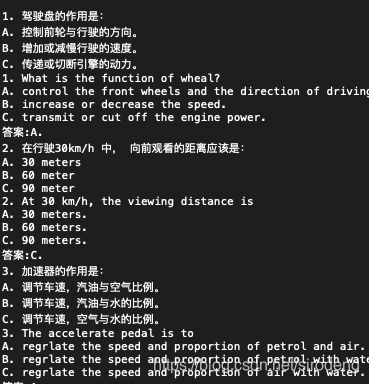题库txt:

代码:
import sys
import re
import sqlite3
cx = sqlite3.connect('./avpig_sde.db') #创建数据库,如果数据库已经存在,则链接数据库;如果数据库不存在,则先创建数据库,再链接该数据库。
cu = cx.cursor() #定义一个游标,以便获得查询对象。
cu.execute('create table if not exists a41 ([_id] integer PRIMARY KEY AUTOINCREMENT, [content] varchar NOT NULL, [answer] varchar NOT NULL, [parse] varchar, [note] varchar, [type] int NOT NULL, [chapter_id] varchar NOT NULL, [url] VARCHAR)') #创建表
content_list=[]
anwser_list=[]
# 第一种写法
# patch_file_name="gj_1.txt"
# patch_file=open(patch_file_name,'r') #打开文档,逐行读取数据
# content=patch_file.read()
# patch_file.close()
# content_list=re.split('[答][案][:][A-D][.]', content)
# #print(content_list)
i = 0
#第二种写法
with open('gj_1.txt','r') as f1:
contents = f1.read()
content_list=re.split('[答][案][:][A-D][.]', contents)
print(content_list)
with open('gj_1.txt','r') as f:
for line in f:
index = line.find('答案:')
print(index)
if index != -1:#表示没有找到“答案:”
anwser_list.append(line[int(index+3)])
print(anwser_list)
print(content_list[i])
cu.execute('insert into a41 (_id, content, answer, type, chapter_id) values (?,?, ?,?,?)',(i+1, content_list[i].strip(), anwser_list[i].strip(), 1,"1."))
i +=1
#anwser_list.append(list(line.strip('\n').split(','))[0])
# print(anwser_list)
# print(content_list)
cu.close() #关闭游标
cx.commit() #事务提交
cx.close() #关闭数据库注释:
-
首先连接SQLite3数据库
-
之前没有数据库就直接用SQL语句创建。
-
读txt文件到内存中,读成 list[]
-
再用SQL语句导入SQLite3数据库
-
关闭数据库
知识点:
1.读取txt文件有这里有两种写法,第一种
patch_file_name="gj_1.txt”
patch_file=open(patch_file_name,'r') #打开文档,逐行读取数据
content=patch_file.read()
patch_file.close()
content_list=re.split('[答][案][:][A-D][.]', content)
这里用了正则表达式:
[答][案][:][A-D][.] 表示 匹配 “答案:A到D” 的所有结果。
2.读取txt文件的第二种写发, with open
with open('gj_1.txt','r') as f这种方法不需要再去写close文件的代码,他会自动去close。可以整体读取用read(),输出结果是一个list[]. 也可以用 for … in… 遍历出每个元素。
3.split函数,表示把list按照给出的参数进行分割。
content_list=re.split('[答][案][:][A-D][.]', contents)
4.strip()函数,表示去掉字符串两头的空格。
anwser_list[i].strip()e.g 我是头部空格__我是内容__我是尾部空格.strip() -> 我是内容